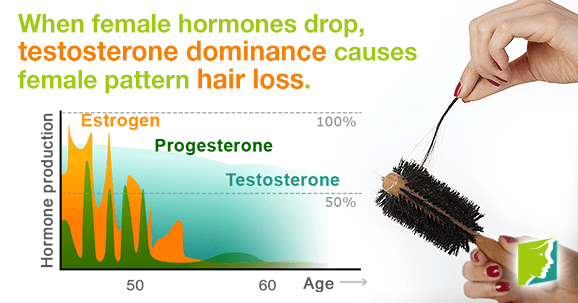More than 25% of women over the age of 50 experience significant hair loss. Perimenopause causes a number of physical and emotional changes to the body, one of which is hair loss. In some women, hair loss during menopause can trigger profound self-confidence issues. Hair loss is usually caused by hormonal imbalances, such as high testosterone.
What Is Testosterone?
While testosterone is a hormone usually associated with men, it is produced by both men and women - just at different amounts. Women produce hormones in the ovaries called androgens, and testosterone is the most prominent of these. Like in men, a woman's androgen levels play a role in puberty, sexual function, and mood.
Testosterone and Hair Loss
Hair grows at a rate of around half an inch per month for two to six years before stopping and falling out, after which new hair grows in its place. Though the exact links between androgen and hair growth are not known, testosterone has a significant role in stimulating the regrowth part of this process.
During perimenopause, women are prone to testosterone fluctuations. Menopause causes declining estrogen levels and increased androgen circulation, which can cause hair follicles in the scalp to miniaturize. This means after natural shedding occurs, there is no regrowth of lost hair. This is known as female pattern hair loss (FPHL).
Recognizing Hair Loss Caused by High Testosterone Levels
The type of hair loss associated with FPHL and testosterone levels is recognizable in appearance; patchy baldness or thin, brittle hair widens out from the center part and is evident mainly on the crown of the scalp, while the front hairline remains intact. Near or total baldness in FPHL is very rare, and the condition is neither itchy nor painful.
Other symptoms of higher testosterone levels may include: excessive hair regrowth in other areas of the body (e.g. face, stomach, or arms), irregular periods, acne, decreased breast size, and increased clitoris size.
Treating FPHL
At this point, there is no known cure for FPHL. High testosterone treatment programs are available, which may have an effect on hair loss over time.
However, there is no denying the emotional repercussions of the condition - one study reported that 52% of women were “extremely upset” by hair loss compared with only 28% of men - so options for dealing with it are essential, and generally fall under two categories: concealment or compensation. Cosmetic disguises, such as wigs, scarves, or headpieces, are popularly used to conceal FPHL. Compensation means accentuating other parts of the body (e.g., by wearing flattering outfits, lipstick, or nurturing to enhance the condition of hair that has regrown) to reinstate confidence and positive self-image in spite of hair loss.
While FPHL is the most common explanation for hair loss in women in their forties and fifties, other causes such as dietary deficiencies, stress, hair care habits, or certain medications may also trigger or exacerbate the symptom. There are many natural remedies to counter this.
Sources
- Dinh, Q.Q. & Sinclair, R. (2007). Female pattern hair loss: Current treatment concepts. Clinical Interventions in Aging, 2(2), 189-199. Retrieved from http://www.ncbi.nlm.nih.gov/pmc/articles/PMC2684510/
- National Institutes of Health. (2012). Female pattern baldness: MedlinePlus Medical Encyclopedia. Retrieved April 24, 2014, from http://www.nlm.nih.gov/medlineplus/ency/article/001173.htm
- National Institutes of Health. (2012). Testosterone: MedlinePlus Medical Encyclopedia. Retrieved April 24, 2014, from http://www.nlm.nih.gov/medlineplus/ency/article/003707.htm
- American Hair Loss Association. Causes of Hair loss. Retrieved August 7, 2015 from http://www.americanhairloss.org/women_hair_loss/causes_of_hair_loss.asp




